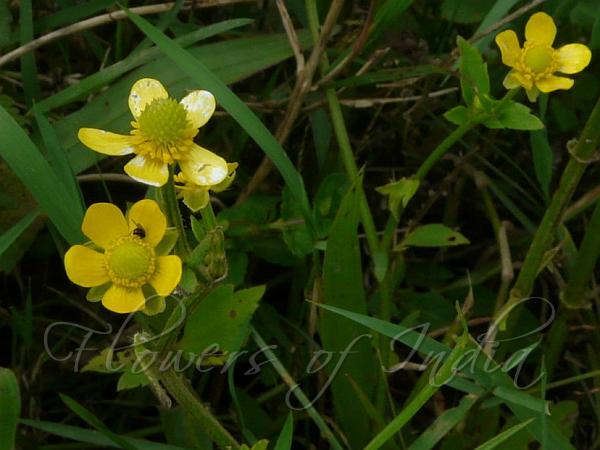|
| Celery-Leaved Buttercup |
|

|

| File size | 154909 |
| Original date | 6/24/18 3:33 PM |
| Resolution | 2560 x 1920 |
| Flash | Flash did not fire, auto |
| Focal length | 4.6mm |
| Exposure time | 1/250s |
| Aperture | 5.6 |
| Focus Distance | |
| Metering Mode | Spot |
| Camera make | Panasonic |
| Camera model | DMC-FZ18 |
| Sensor type | OneChipColorArea |
|
|
|
|
Photo: |
Botanical name: Ranunculus sceleratus Family: Ranunculaceae (Buttercup family)
Synonyms: Ranunculus indicus, Ranunculus umbellatus
Synonyms: Ranunculus indicus, Ranunculus umbellatus
Celery-Leaved Buttercup is a fast growing annual herb which produces a multitude
of small yellow flowers. The flowers have three to five yellow petals 2-5
× 1-3 mm and reflexed sepals as long as petals. The leaves have small
blades each deeply lobed or divided into usually three leaflets, and look
like coriander leaves. They are borne on long stalks. The fruits arise in
heads 5-13 × 3-7 mm and make the plant easy to identify.
Celery-Leaved Buttercup is a very poisonous plants. Bruised and applied to the
skin, it raises a blister and creates a sore which is by no means easy to
heal. When chewed, it inflames the tongue and produces violent effects.
Celery-Leaved Buttercup is found at altitudes up to 1700 m in Europe, C. Asia,
Himalayas, N. India, Siberia, Mongolia, China, Japan, N. America. Flowering: February-June.
Medicinal uses: When made into a tincture, given in small
diluted doses, it proves curative of stitch in the side and neuralgic
pains between the ribs.
When made into a tincture, given in small
diluted doses, it proves curative of stitch in the side and neuralgic
pains between the ribs.
Medicinal uses:
 When made into a tincture, given in small
diluted doses, it proves curative of stitch in the side and neuralgic
pains between the ribs.
When made into a tincture, given in small
diluted doses, it proves curative of stitch in the side and neuralgic
pains between the ribs. | Identification credit: Gurcharan Singh | Photographed in Imphal, Hoogly & Delhi. |
• Is this flower misidentified? If yes,